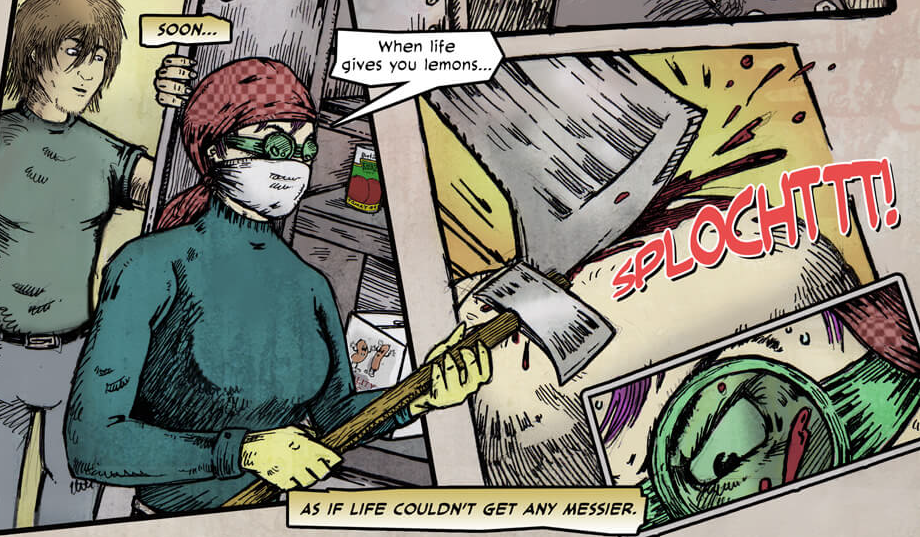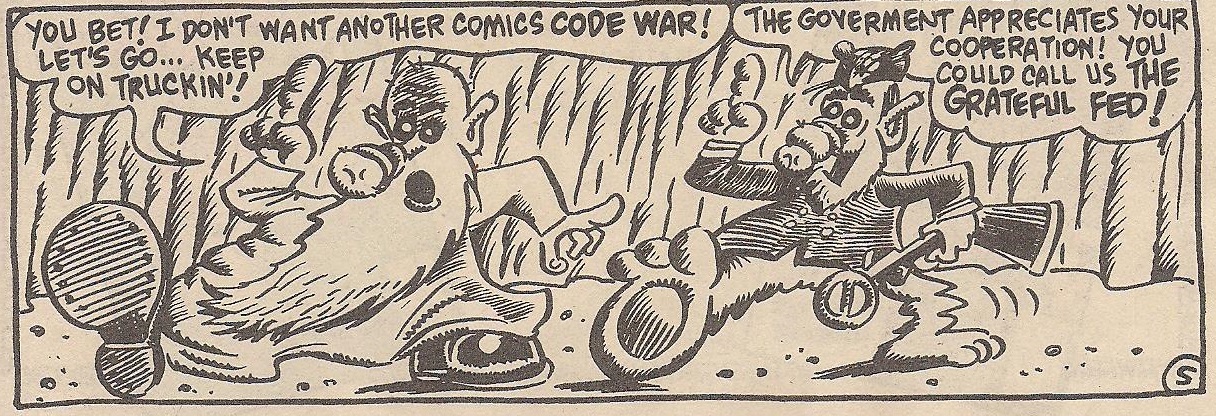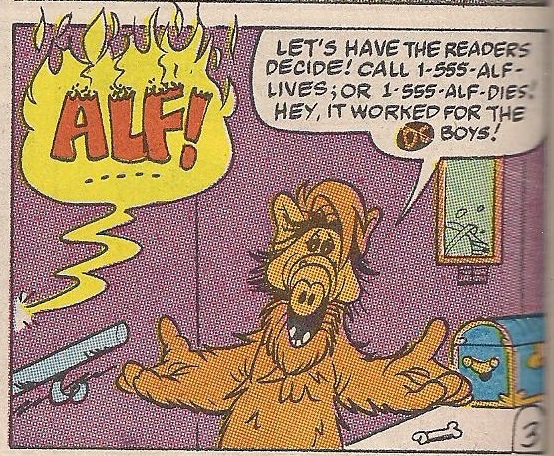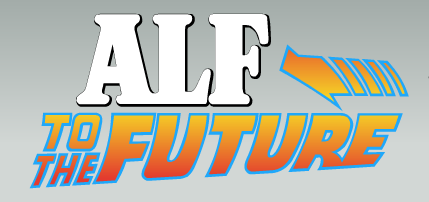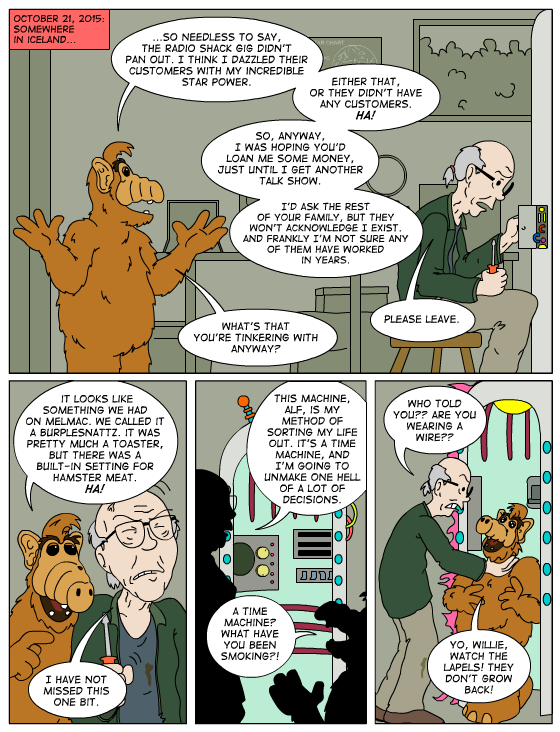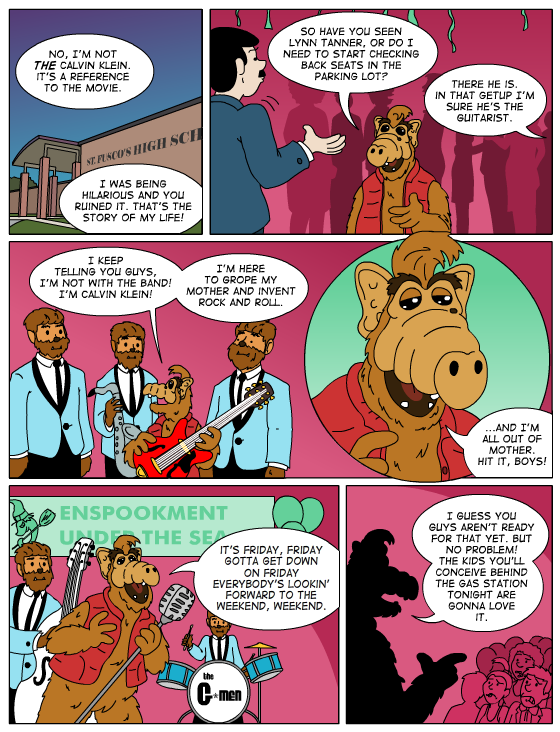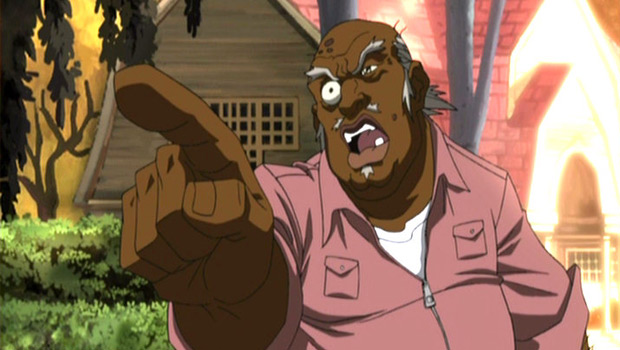Last week’s episode was a real garbage pile, and I’ve been busier than a [funny metaphor], so I thought I’d turn some space over to Larry-and-Balki-fucking.gif enthusiast Casey Roberson. And by that I mean I forced him to buy all the ALF comics and suffer through them for our amusement. Anyway, Casey’s a good guy and doesn’t deserve to be treated like that, so please join me in pointing and laughing at his misery.

Fusco’s Four-Color Funnies
or
ALF’s Got Issues!
Beginning in December 1987*, any kid with $1 could stroll down to their local newsstand or comic magazine specialty retailer and trade it for 34 pages of comics featuring Gordon Shumway, star of the hit television show ALF. (Well, okay, 22 pages of comics and 12 pages of ads, but this theoretical kid obviously wasn’t too picky.) By 1988, ALF the television show was halfway through its second season, and ALF: The Animated Series had also been on the air for four months. ALF’s popularity was an established fact, and Marvel comics knew that they had a winner on their hands. The timing of the comic’s debut couldn’t have been better planned: what child, after watching “ALF’s Special Christmas,” could resist the allure of spending even more time with the one alien who could decide the mortal fates of both vaginally-cancerous preteens and suicidal black Santas alike?
What these brave souls would find, month after month for over four years, were two or three stories per issue featuring ALF’s life with the Tanners, ALF daydreaming, ALF’s former life on Melmac, and stories about Melmacian history and myth. I’ve not watched either of the cartoon series, but those last two categories of story were there for kids who did. Let’s make that clear upfront: this comic was for kids. ALF was (sort-of**) one of many comics in Marvel’s “Star” imprint, which also featured properties such as Police Academy: The Series, Count Duckula, and Heathcliff (you even see ALF reading an issue of Heathcliff’s Funhouse in the episode “It’s My Party”).
My purpose here is to compare ALF the comic to ALF the sitcom (or ALF as seen through this site’s phil-ter. Ha! Don’t kill me). Thus, I’ll primarily be looking at a handful of stories taking place in the same world as the sitcom. When I first started looking through these, I realized that I had forgotten how frenetic kids’ comics in the 80s could be. Everyone runs everywhere, ALF spits out dozens of puns every issue, many of them plays on the Tanners’ names (Katy-did, Lynn-a-mint, they get worse after that). Plus ALF eats just about every funny-sounding thing the writer could think of: peat moss, videotape, styrofoam stew, squid, plastic shopping bags, slug fritters, “Yoda Soda”. It’s very much an approach in the same vein as Will Elder’s “chicken fat” style in early MAD comics***.
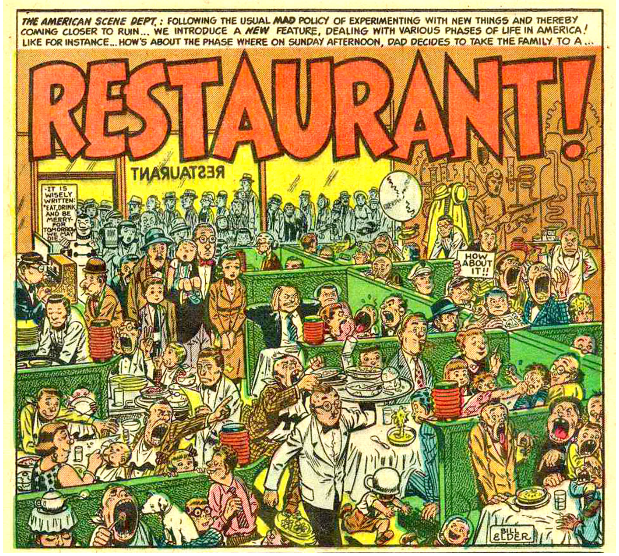
ALF the comic series ran for 50 issues, ending in November or December of 1991*. Of particular note is that, with very few exceptions, every story in every issue of ALF was created by the same main team: writer Michael Gallagher, penciller Dave Manak, and inker Marie Severin. Let that sink in for a moment–at least 100 ALF stories written by the same guy, drawn by the same two artists. The sitcom, if you split up the two-parters, had 102 episodes and 45 writers, with writer Steve Pepoon getting credit on the highest number of scripts (12).
Gallagher, Manak, and Severin were established comics creators at that point, with even some family history in comics. Gallagher’s uncle George Gately had created Heathcliff, and Severin’s older brother John worked for Cracked Mazagine for almost 50 years. If you read any kids’ comics put out by Marvel or Archie in the late 80s or early 90s, you’ve likely seen the work of at least one of these three. And if you found this page because you’re a real-live fan of the ALF comic series, it looks like Dave Manak still might be taking on artwork commissions. Comics artists like to eat, too, and while peat moss may be dirt cheap (HA!), squid can be pricey.
Anyway, enough context; let’s move on to the content. Here are 20-odd stories from the ALF comic series that Phil said he would be interested in reading about. If these turn out to be total garbage and Phil loses half his readership, I have email proof that it’s his own damn fault.
Issue 1

The first issue (Dec. 1987) is basically just a recap of ALF’s origin story; the framing story ends with ALF’s spaceship crashing into the Tanners’ garage a second time. A very shruggy–though appropriate–“here we go again!” kind of opener.
Issue 3 – “Travels with Willie”

You could, if you chose, view ALF’s “WOTIF” machine as fitting in Marvel’s long-running title What If…, which explored alternate histories where some tiny change was made. “What if the Dazzler had become the herald of Galactus?”; “What if Elektra had lived?”; “What if artists like Jack Kirby and Stan Ditko got the creator credits they deserved?”. Anyway, thanks to ALF’s “WOTIF” machine, Willie is somehow an astronaut on “exploratory patrol”. When he reaches Melmac’s atmosphere, he passes out, and his ship crashes in the Shumways’ garage, meaning…

…oh, wait, hold on, Marvel decided that holding an issue in their hands wasn’t enough for its readers to realize ALF was a comic now…

The Shumways instantly have to hide Willie from their nosy neighbor, Pete Zaparlor. Willie faces off with the Shumways’ pet, Neep, and we have our first instance of the comic’s reliance on foot-long tongues. He is introduced to Gordon’s family, which at least here, if not in the cartoon, is quite literally a family of ALFs. At their first dinner, they eat “slimeball surprise”, and though he’s initially put off by their cuisine, I think it’s safe to assume that Willie eats a lot of pussy while on Melmac.

Pete Zaparlor instantly reports the Shumways to the USC (the Unscrupulous Scientists Conglomerate), which consists of Dr. Strangeglove and his assistant Ybor. I get that we’re working with cartoon and comic book tropes here, but I do find it interesting that everybody’s super-cool with a mad scientist living basically down the street. Also interesting that Pete is acting more like a human than anyone on the TV show ever did (P.S. cross-dressing is a thing on Melmac, according to dialogue between the Dr. and Ybor). The pair quickly fool the Shumways, absconding with Willie. The story ends with Gordon fixing Willie’s ship and killing Dr. Strangeglove and Ybor. One of the guns shoots right up Ybor’s butt. What a great story for children!
Super-Sized ALF annual #1 – “The Return of Rhonda”

Rhonda crashes into the Tanners’ garage, and she and ALF have a nice quickie before coming into the house. After ALF gets her not to eat Lucky, she sits down to dinner with the Tanners (Rhonda eats her place setting). She recounts the story of how she and Skip, after missing the rendezvous with ALF–the comic mentions the TV episode in an editor’s note–land on a habitable planet and name it New Melmac. She then returns to Earth to try to convince Gordon to come with them, and…wait. So she came deliberately, knew where she was going, grew up on a planet with garages, likely knew the ATF risk…and still crashed through the roof of the garage. It’s enough to make even Brian mad! Rhonda cooks up a batch of styrofoam stew, sprays Lynn’s sweater with “eau de Force Field”, soups up Willie’s car just enough to get him a bunch of speeding tickets. Brian decides he can’t live without ALF, so he attempts to run away and join the circus. Gordon catches him, and because of a misspelling in his goodbye letter (“clone” instead of “clown”)–

…oh, wait, hold on, we’ve got to pause for an advertisement for the very issue I’m holding in my hands…

Okay, Rhonda’s ship is equipped with a Clone-O-Matic, and she will return to New Melmac with one of Gordon’s nose hairs. By the time she arrives, she will have another Gordon. Brian’s so happy that he makes the same face I do when I have a stroke.
“Back to Human Nature”

Let’s take a look at a story that the show had already done: ALF goes camping with the Tanners. Here’s where, in some ways, comics has the edge on the television. TV shows might feel the need to spend two or three minutes in the “default” setting to establish what the characters will spend the next 20 doing. In comics–a world where Spider-Man can deliver a soliloquy while punching the Green Goblin–you can just open with a splash page explaining why the characters are where they are. The fact that you don’t have to saw holes in the floor to make comics helps out, too.

This story begins with Kate reminding ALF that he has agreed to “behave” on their camping trip. Unfortunately, ALF is allergic to some sort of weed and almost sneezes himself off a cliff, so the Tanners spend the beginning of their vacation pulling up weeds instead of, I don’t know, moving their van. ALF wakes up just in time for Willie to tell a ghost story…oh, no, wait, the comic just tells us that Willie tells a ghost story.
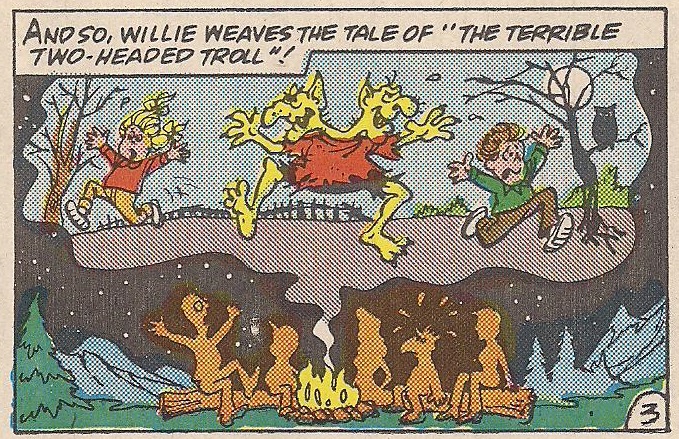
A noise wakes ALF in the middle of the night, but instead of this being, oh I don’t know, a good chance to have ALF believe ghost stories, it’s a bobcat. So ALF chases the bobcat. Willie follows him, they get lost in the woods, ALF sneezes some more, and they get rained on. They seek shelter in a cave, and because of the unspoken rule that no character in any piece of mainstream media may be genre-aware, Willie and ALF are surprised to find that it’s a bear cave. Willie grabs ALF and high-tails it out of the cave, only to discover that he took a baby bear by mistake. Willie and the mama bear have a stand-off, but thanks to ALF’s hither-to unknown ability to talk to bears ( ¯\_(ツ)_/¯ ), it gets settled pretty quickly.

Re-reading the review for “On the Road Again”, what strikes me most is Phil’s comment that the episode is ultimately “just a mess of moments that occur in sequence but have little to no bearing on each other”. That’s an accurate description of this story, too! But that kind of slapdash plotting works–and is expected–in comics. Kids’ comics are much like kids’ cartoons. There’s often no more reason necessary for two different scenes to exist side-by-side than that they take place in the same setting. Gunfights and stagecoaches and Injuns and saloons all take place in the Wild West, so let’s have Woody Woodpecker interact with all of them! Who needs transitions? You chase a bobcat, and then you walk over this way, and now you get chased by a bear. Is ALF trapped? Instead of having him whimper at rednecks, just have him suddenly speak bear! Hell, Superman got a couple new powers every week when he was starting out.
Issue 8 – “The Boy Next Door”

This time, ALF’s WOTIF machine shows us what would have happened had Gordon Shumway’s ship landed in the Ochmoneks’ house. It turns out, first of all, that they would still call him ALF (“Adorable Little Fuzzball”). ALF wastes no time making jokes about how all of his family and most of his friends died when his planet blew up.

The Tanners come over to make sure everything’s all right, proving that comic writers can do in one panel what sitcom writers can’t do in four years. Being a devoted fan of midget wrestling, Trevor says that he’s going to train ALF to become “The Hairy Hobgoblin”. ALF, however, doesn’t want his presence known, and just wants to stay around the house, I guess because everything’s backwards in this story. After that, it’s just a series of jokes: ALF eats Raquel’s Royal Doulton figurines, and then ALF blows up Willie’s lawnmower while Trevor tries to repair it (okay, maybe everything’s not different). It’s implied that ALF and the Ochmoneks establish a new normal over time; ALF even adopts Trevor’s fashion sense. However, when the Ochmoneks watch Carl Waygone’s space TV show they realize they could make billions of dollars off of ALF on movie and merchandising rights.

Fearing for his life, ALF drugs them and leaves in his repaired spaceship. Not knowing where to go, ALF decides to land in the Tanners’ garage because they have a cat that he maybe could eat.

Back in real life, ALF decides to send the Tanners on a Philip K. Dick-style mindfuck by suggesting that maybe they’re in the simulation.
Melmac Fact: The sky is green on Melmac.
Issue 15 – “The Run Run Run Run Runaway”

ALF runs away, meets a hobo, goes to Las Vegas with the hobo, they win a bunch of money, ALF tells the hobo a Melmac story about William Shumspeare, ALF loses their money, ALF joins the circus, and then ALF goes home. That’s it. That’s the story.
Issue 16 – “Surrender Dorothy”

Whiny-ass ALF throws a temper tantrum because he doesn’t want to be babysat by Kate Sr. while the Tanners go “upstate” to Willie’s family reunion. I assume he doesn’t get to go lest he kill off the rest of Willie’s relatives. From the time she gets there until 5 pages later, ALF directs a steady stream of insults at Kate Sr. His response to her initial offer of truce is to electrocute her; when she cooks him a meal, he kicks it down the stairs; when she takes two minutes to have phone sex with Whizzer Deaver, ALF listens in and masturbates.

ALF decides that, since Kate Sr. is SO MEAN to him all the time, he should trot out the tired old plot where you divide up living space by painting all over everything (tape? what’s tape?). But then Kate Sr. starts choking on scrambled eggs, ALF gives her the heimlich, Kate Sr. becomes ALF Fan #1, and the story’s over.

(By the way, penciller Dave Manak must have been a fan of Anne Meara, because she is drawn so much more screen-accurately than any of the other characters in the comic, and that includes ALF, whose head grew and body slimmed over the comic’s 4-year run.)
Issue 17 – “Melmac to the Future”

After playing roller derby in the kitchen (ALF wears a derby while on roller skates…do you get it…do you get the joke), ALF fires up his WOTIF machine to show the Tanners what things will be like for them in the year 2020. It’s quickly established that everyone on earth has a spaceship that looks exactly like ALF’s, ALF lives on New Melmac, and the aged Tanners live in a condo.

ALF says he has a plan to attend the Tanner family reunion so that it won’t be known he’s an alien–the fuck? Then why did you just fly into the Tanners’ garage in broad daylight a panel ago? Anyway, he straps on a “holo-humanizer”, which makes him look like Abraham Lincoln’s long-lost fat red-haired brother.

“Uncle Gordon” meets the grown-up Lynn and Brian and their families. Brian married someone named Ruth and had a daughter named Dottie; Lynn has a daughter named Leslie; there’s other people there, but they don’t get names so there will be room for ALF to meet his pun quota for the issue. Then ALF’s holo-humanizer malfunctions and, after two panels of the extended family not knowing what’s going on, they accept him into the family. Even for the ALF comics, that’s a short resolution! But we really needed three whole panels about how ALF’s planet blew up. There’s a tiny bit of room left for stuff like what Brian and Lynn do for a living (used car salesman; baby machine), but none for having anyone react substantially to the first alien they ever see!

By the last two pages, the artist started doing what I do when I have to draw a bunch of crowd scenes: take the lazy way out with a lot of silhouettes.
Super-sized Spring Special – “Love is in the Hair”

Brian comes home from school one day with his eyes wide and spiraling, like he’s on glint or something. Kate expresses her worry that Brian’s been “preoccupied” lately, so ALF uses his X-Ray specs to look through walls. It turns out Brian’s been masturbating to a girl in his class photo!

After beating the name of the girl out of Brian (“Laura Nelson”), ALF decides to help Brian win over the girl using his tried-and-true Melmacian methods: cologne (Brian ends up smelling like rotten fish) and candy (Brian gives the girl one that tastes like squid, and how either of them figured out that it was squid is beyond me). Brian gets so angry at ALF that he starts emanating, I dunno, stink lines? His spider-sense?

ALF, rather than feeling remorse at screwing things up for Brian, calls up Laura and hypnotizes her over the phone, turning her into a pliant sex doll for Brian’s amusement. Kate launches into a three-page verbal manifesto against blatant sexism in children’s comics and the overall rape culture of late 1980s America, all while bashing ALF’s head in with his WOTIF machine. Nah, j/k, Kate just gets angry in the background of one panel and tells Brian to just “be himself”, which gets him an actual movie date with Laura.

So if you were wondering if the comics upheld the ALF standards of being rapey, and never getting to see boyfriend/girlfriend characters again, there you go.
Issue 19 – “Swimsuit issue”

Kate is silently fuming because Willie just got the swimsuit issue of “Sports Reports” in the mail. ALF uses this as an opportunity to play a power move, roping Willie and Kate into a game of “Let’s You and Him Fight” (see Berne’s Games People Play, 1964).

The writer comes to his senses about three pages in and shifts the story away from the mere idea that Willie could ever achieve erection; to ensure that it doesn’t happen, first Lynn comes home with a bikini, and then ALF wears it. Thanks to the showercams he installed (in issue 13’s “Here’s Lookin’ at You, Naked”), ALF is able to sew a bathing suit that fits Lynn perfectly.

But then we find out that the material ALF used–a seat cover from his spaceship–shrinks in salt water so Kate and ALF race to the beach where Lynn can put on the bikini she bought in the first place.

Knowing that the target audience for this comic (boys aged 8-11) would be too focused on the girlflesh on display, the writer knows he can end the story with ALF just standing around in broad daylight on a public beach and nobody will think twice about it.

P.S. Kate is pregnant in the issues that came out between the end of Season 3 and Season 4.
P.P.S. If you ever wondered just how many of those Melmac facts ALF made up, this issue informs us that his planet had a “Spanish Olive – American War”. “Melmac Facts” my ass.
Issue 20 – “Vanity, thy name is ALF”

ALF inhales talcum powder, which makes him want to be beautiful; he gives himself a full-body perm, then breaks into a cosmetic surgery center in the middle of the night. He fights a cleaning lady and breathes ammonia, which fixes him.
Super-Sized Annual #2 – “Interview with the Hampire”

A Melmacian vampire lands on Earth, and his name is Melmacula. Hampires went around Melmac sucking the cholesterol out of people, leaving them zombies craving saturated fats. At this point, I think I need to get hard (hard sci-fi, that is). Let’s look at some premises here, based on information given. Like the earliest iteration of Cookie Monster, comics ALF eats everything, including tons of regular human food. When comparing humans to Melmacians, there’s some level of evolutionary convergence. ALF poops, has sexual urges, has available cholesterol to be violently sucked out of his neck; he’s basically just like you. So, if Melmacula had been feeding off of Melmacians who had items like bacon, cheese, and palm oil in their diet…why not just capitalize on the obesity epidemic in America? Ah…the comic tells us that–despite being no doubt famished after flying through space for years–he “prefers” Melmen to “foreign food”. So even the undead on ALF’s planet are whiny-ass little shits who demand to get their way all the time.

Anyways, Hampires can be defeated by getting them to bite you after you’ve eaten only foods that let you make shitty puns (I refuse to repeat it, just look at the panels). ALF kills the fourth being to survive the destruction of Melmac, turning him into some kind of shiny sheet. Kate slept through this story. The end.
“Oh, Baby!”

I’ve been impressed so far with the level of commitment that the ALF comics have to the show’s continuity, at least in terms of major events and characters. We don’t see Dr. Dykstra, or Jody, Jake, or even Neal, but we do get Eric Tanner, utilization of the time ALF was supposed to meet Skip, and a number of be-asterisked editor’s notes referencing specific episodes. So it makes perfect sense that, when ALF eats all the food on the way to Eric’s first family picnic, Kate & Willie select a novel way of neglecting their new baby: leaving it alone with ALF and Lynn in the middle of nowhere. (In another bit of continuity, Brian is largely forgotten in the backseat of the car, and doesn’t even get 10 words in this story.) ALF gives Eric a “Getty Bear” (a teddy bear but it’s from Melmac and the name involves some stupid pun or something, who cares).
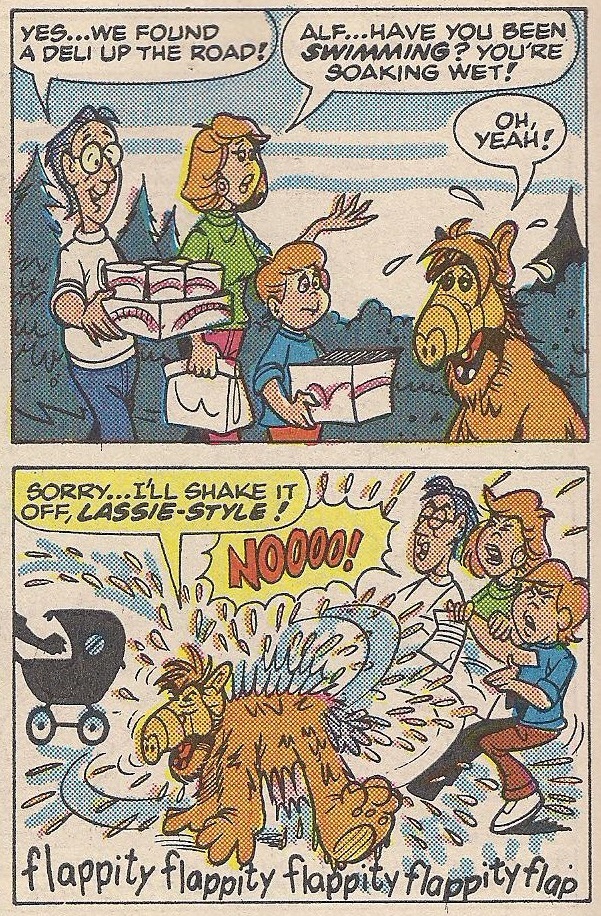
The toy is a robot and when they turn it on, it runs away with Eric’s carriage and pushes it down a hill into a river. ALF does some weird stuff and saves the baby. When the rest of the family gets back, ALF shakes all of the water off of his fur. The Tanners are oddly happy and amused by this, like ALF didn’t just throw a bunch of polluted water onto the food they plan on eating. Eric slept through this story.
Issue 22 – “Food for Thought”

Lynn gets a job working for “Chris the Caterer”, which is only ever said in quotes, so it’s not clear for awhile if it’s a company, or just some guy who’ll stop by your house with a couple cans of Chef Boyardee. But five panels in and ALF has already jumped to the conclusion that Chris is a pimp (ALF actually says “gigolo”, because you probably couldn’t say “pimp” in comics back then). Yikes! Did ALF ever imply that Lynn was just a whore waiting to happen, Phil? Did he disguise his own opinions under the cloak of concern by projecting them onto her boyfriends?

Anyway, when Willie sees Lynn’s work uniform–a French maid outfit–he buys into ALF’s fear-mongering and they follow Chris’s catering van to spy on Lynn. Well, okay, once they get there, it’s really just ALF spying on her and Willie sitting in the car masturbating. ALF tries to rescue Lynn by throwing a sheet over her head and taking her back to the car–only to find out that he grabbed Lynn’s boss instead! Whu…?! “Chris” is really “Christine”? Oh, well, in that case, of course it’s a legitimate catering business! Women can’t be pimps / gigolos!

Anyway, Willie has to pretend to save Christine from ALF so that ALF won’t be seen, Christine showers Willie with kisses (the first one’s free, kids), ALF eats everything in the catering van, end of story. The fact that ALF caused a struggling independent businesswoman to not be able to deliver a service and get paid is not mentioned, but I’m assuming that Christine could no longer afford Lynn, and this is why her catering job is never, ever mentioned again, even in an asterisk note.
Issue 24 – “Rhonda’s Residency”

Here we go again with another “WOTIF” story. After two years, and with 2-3 stories per issue, ALF the comic had filled in a lot of the empty spaces of the universe it borrowed from ALF the show. I’ve skipped the ongoing story of ALF having multiple run-ins with a “coat burglar” (you’re welcome), as well as how, every few issues or so ALF becomes the mascot for a different sports team (you’re welcome), but there are some stories in the comics that had legitimate, lasting consequences. This WOTIF story is an imaginary sequel to “The Return of Rhonda”–a sequel where Rhonda sticks around for longer than five pages. We do have to waste half a page just so ALF can make one more heartless joke about his family dying, but then the actual story starts. ALF and Rhonda get married, Rhonda runs up the utility bill with her hair dryer, ALF puts down Kate Sr., and the couple settle into their new domestic life in the garage.

Despite having already outpaced the TV show for the number of times ALF has gone out in public, Rhonda gets captured and turned over to the ATF almost instantly when she gets cabin fever and decides to go shopping at the mall. Here’s some comics logic for you: Rhonda walks around the city and gets captured; then ALF flies her spaceship around to rescue her and doesn’t. The difference? Rhonda isn’t ALF, but ALF is. ALF cannot get captured because his name is on the cover. Anyway, ALF saves Rhonda from the Alien Task Force, Rhonda leaves Earth, ALF turns off the WOTIF machine and eats some brownies with fish in them. You know what? This is the first comics story that I’ve just out-and-out disliked. Not just the gender disparity in comics logic (those ditzy dames, always risking dissection!), and not even the fact that it took ALF two minutes to infiltrate ATF headquarters (like, I could go on for probably a thousand words about how simply knowing where the place is would be a total game-changer for the Tanners). But the fact that the writer made this into a WOTIF story rather than an actual in-canon one borders on ridiculous. I mean, Melmacula is canon! Kate being happy that ALF didn’t leave with Rhonda and Skip is canon!

I can only imagine that writer Michael Gallagher came up with the story idea of Rhonda living with the Tanners and then, when he realized he didn’t have enough pages of material, made it a WOTIF story. Also, I hate that damn word. WOTIF. WOTIF I just stopped reading the WOTIF stories.
Super-sized ALF Holiday Special #2 – “Don’t Toy With Me”

ALF is excited that he gets to go to “The Mall” with Willie (that’s right, you heard right, the sign on the building says “The Mall”). Lest you think that this means Willie has figured out from issue #24 a sure-fire way to get ALF captured by the ATF, we quickly find out that ALF is content to sit in the parking lot and floss his teeth. His four teeth. Then some guy breaks into Willie’s car, ALF pretends to be a toy…you know what? We’ve already done this “ALF pretends to be a toy” mess twice: once in the show’s second Christmas episode, and once in the ALF Holiday Special #1.

Does this issue have any other Christmas stories? Let’s see…ALF is a hockey mascot…Gornan the Barb-Q-Barian meets the Melmarx Brothers…ooh, ALF meets Santa! nope, just a dream…ALF tells a story about the “Uncanned X-Melmen”…a story where ALF tries to convince the Tanners that the Melmacian New Year’s tradition is for the eldest child to “skin a snake”.

Those brave souls who trudged through a blizzard to reach the comic shop in December 1987 held out hope for two full years, but by December 1989 it must have been clear to even the most clueless 10-year old: there would never be a good ALF Christmas story.
*throws this issue away*
*remembers plan to sell these on eBay when review is finished*
*curses*
—–
* I don’t buy monthly comics anymore, so I can’t say if this is still common practice; but back in my day, comics and magazines would have a cover date one, sometimes two, months into the future. This was a little way of gaming the system for newsstands and grocery stores, who had procedures directing them to keep titles on display until the date on the cover had passed. Using some internal clues from a few issues, it appears that ALF sported a cover date a full three months out, which if you ask me is just plain greedy.
** Not identified as such on the cover, but the advertisements were predominantly for other Star Comics, and ALF makes mention of his comic as falling within that line at one point.
*** “Chicken fat” – it does nothing for the nutritional value of a soup (that is, does nothing to advance the plot), but adds lots of flavor.
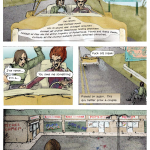 Artistically, Prime Cuts is a mixed bag. The first volume’s art by Rob Gutman would be easy to dismiss as amateurish (at best) or just terrible (at worst). It’s not great, but Gutman’s line work in places is surprisingly strong. Closeups of faces look good, and he manages to keep his characters details looking consistent, which is something a lot of artists struggle with. It’s when his characters interact physically, either with each other or the environment, that the problems begin to show, as his figures lose themselves within the panels, floating weightlessly. It’s the nature of drawing sequential art, as opposed to simple figure drawing, that your figures need to reside within a picture, within a story, and while Gutman’s work isn’t entirely without merit, often this aspect escapes him.
Artistically, Prime Cuts is a mixed bag. The first volume’s art by Rob Gutman would be easy to dismiss as amateurish (at best) or just terrible (at worst). It’s not great, but Gutman’s line work in places is surprisingly strong. Closeups of faces look good, and he manages to keep his characters details looking consistent, which is something a lot of artists struggle with. It’s when his characters interact physically, either with each other or the environment, that the problems begin to show, as his figures lose themselves within the panels, floating weightlessly. It’s the nature of drawing sequential art, as opposed to simple figure drawing, that your figures need to reside within a picture, within a story, and while Gutman’s work isn’t entirely without merit, often this aspect escapes him. In the second volume Gutman is replaced by Stan Maksun, who brings an entirely new feel to Prime Cuts. His ugly, ungainly figures sacrifice a lot of detail but he tells his story much more coherently. His faces look largely the same as each other and much of the posing may not be much stronger than in the previous volume, but his bright, lurid colours go beyond a sense of reality to heighten the extreme nature of the story which, after all, is about murder, cannibalism and a flagrant disregard for health and safety in both the food service and hairdressing industry.
In the second volume Gutman is replaced by Stan Maksun, who brings an entirely new feel to Prime Cuts. His ugly, ungainly figures sacrifice a lot of detail but he tells his story much more coherently. His faces look largely the same as each other and much of the posing may not be much stronger than in the previous volume, but his bright, lurid colours go beyond a sense of reality to heighten the extreme nature of the story which, after all, is about murder, cannibalism and a flagrant disregard for health and safety in both the food service and hairdressing industry.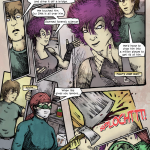 And it comes through time and time again. Our narrator, omniscient, tells us how gross things are, or how awesome something is, beckoning us to take their word over that of the characters. Much of it could be fixed with that age old writing advice “show don’t tell” but that would take the focus off the narrator, which would be the opposite of the book’s main goal. Much like most horror, especially the more sensational and explicit stuff, the audience’s reactions are more important than telling a story about characters, about people, and a failure to connect with that leaves the narrator sounding shrill, egotistical, subjecting people to a story they don’t want to hear.
And it comes through time and time again. Our narrator, omniscient, tells us how gross things are, or how awesome something is, beckoning us to take their word over that of the characters. Much of it could be fixed with that age old writing advice “show don’t tell” but that would take the focus off the narrator, which would be the opposite of the book’s main goal. Much like most horror, especially the more sensational and explicit stuff, the audience’s reactions are more important than telling a story about characters, about people, and a failure to connect with that leaves the narrator sounding shrill, egotistical, subjecting people to a story they don’t want to hear.